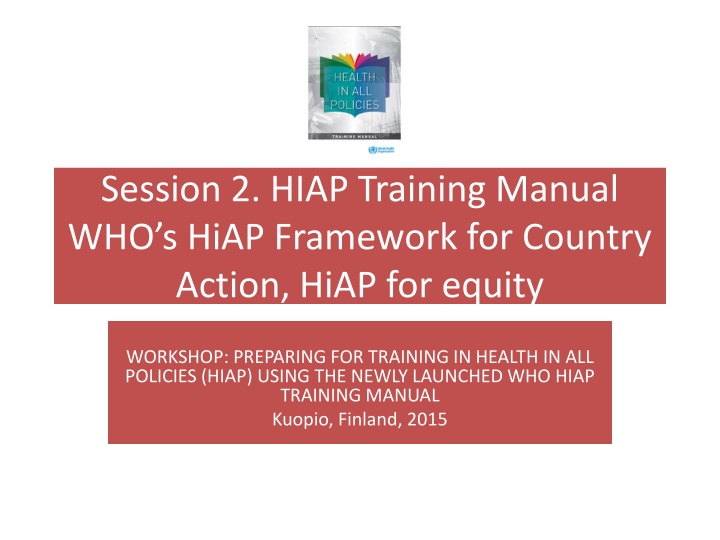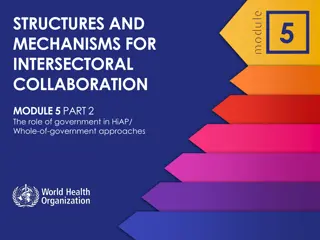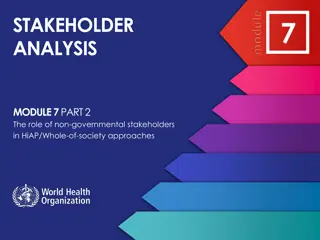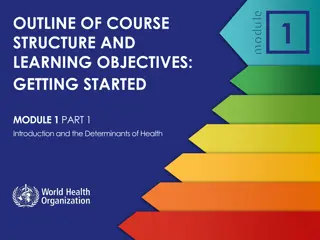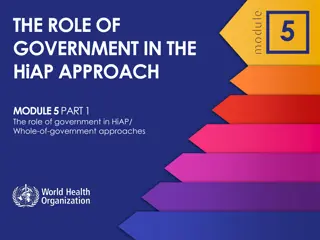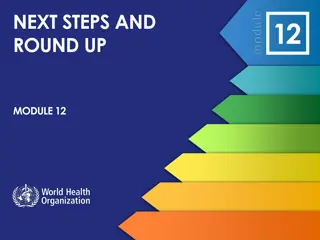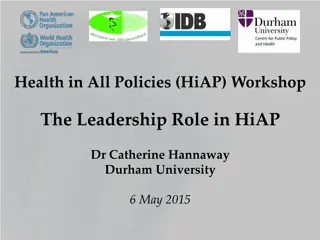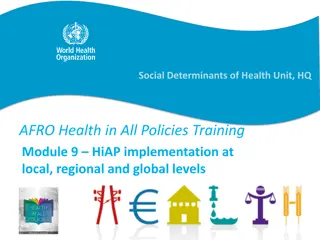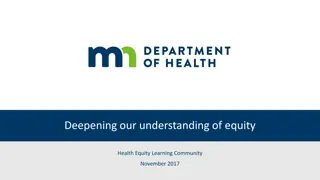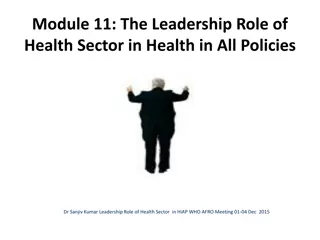WHO's HiAP Framework and Global Mandates for Health Equity
This content discusses the HiAP Framework for Country Action and Global Mandates for promoting health equity. It covers resolutions, declarations, and recommendations by various organizations to address social determinants of health and reduce health inequities. The WHO Director-General is urged to champion health equity, provide guidance for integrating health perspectives in non-health sector policies, and ensure coherence and collaboration across programs. Stakeholder involvement and reporting progress on health initiatives are highlighted, emphasizing the significant impact of non-health sector policies on health outcomes.
Download Presentation

Please find below an Image/Link to download the presentation.
The content on the website is provided AS IS for your information and personal use only. It may not be sold, licensed, or shared on other websites without obtaining consent from the author.If you encounter any issues during the download, it is possible that the publisher has removed the file from their server.
You are allowed to download the files provided on this website for personal or commercial use, subject to the condition that they are used lawfully. All files are the property of their respective owners.
The content on the website is provided AS IS for your information and personal use only. It may not be sold, licensed, or shared on other websites without obtaining consent from the author.
E N D
Presentation Transcript
Session 2. HIAP Training Manual WHO s HiAP Framework for Country Action, HiAP for equity WORKSHOP: PREPARING FOR TRAINING IN HEALTH IN ALL POLICIES (HIAP) USING THE NEWLY LAUNCHED WHO HIAP TRAINING MANUAL Kuopio, Finland, 2015
Global mandates 2011 2014 WHA Resolution 2008 2013 Global Conference on Health Promotion 2006 2011 Rio Political Declaration on Social Determinants of Health 2011 UN Political Declaration on NCDs 2008 Report of the Commission Social Determinants of Health 1997 1988 2006 Finnish Presidency of the European Union in 2006, Health in All Policies (HiAP) 1986 1997 Intersectoral Action for Health- a cornerstone for health for all in the 21st century album25 2009 WHA Resolution Reducing Health Inequities Through Action on the Social Determinants of Health 1978 1986 World Health Organization s Ottawa Charter for Health Promotion 1999 The Gothenburg consensus Paper on Health Impact Assesment 1948 1978 Alma-Ata Declaration Health for All agenda (1970s), action falters in 1980s 1988 Adelaide Recommendation on Health Public Policy Social dimensions of health affirmed in WHO Constitution (1948), downplayed during 1950s era of disease campaigns
2014 Resolution 67.12 Urges Member States : Requests the WHO Director-General: 1. to champion health and the promotion of health equity as a priority and take action on the social, economic and environmental determinants of health; 1. to prepare a Framework for country action across sectors for health and health equity for adaptation to different contexts, taking into account the Helsinki statement on health in all policies; 2. to take steps that enable societal policies which take into account and address their impacts on health determinants, health protection, health equity and health systems functioning; 2. to provide guidance and technical assistance to MS in order to integrate health perspectives in non-health sector policies; 3. to develop sustainable institutional capacity with adequate knowledge and skills in assessing health impacts of policy initiatives in all sectors; 3. to strengthen WHO s role, capacities and knowledge resources, to give guidance and technical assistance for implementation of policies across sectors and to ensure coherence and collaboration across programmes and initiatives within WHO; 4. to take action to enhance health and safeguard public health interests from undue influence by any form of real, perceived or potential conflict of interest; 4. to continue to work with and provide leadership for the organizations in the United Nations system, development banks, other international organizations and foundations; 5. to include relevant stakeholders in the development, implementation and monitoring of policies across sectors; 5. to report on the progress made in implementing this resolution to the Sixty-ninth World Health Assembly through the Executive Board. 6. to contribute to the development of the post-2015 development agenda by emphasizing that policies in sectors other than health have a significant impact on health outcomes, and by identifying synergies between health and other sector policy objectives.
1. Development of Framework for country action across sectors for health and health equity A discussion paper developed and posted on the web 2014 for comments First draft opened for comments until 3 March 2015. Technical reference group met in March 2015 to provide final recommendations Second Draft put together by the Secretariat and presented to WHA in May 2015 Now! 2. Guidance and technical assistance to Member States in order to integrate health perspectives in non-health sector policies Working with Member States for developing, implementing and monitoring National Multisectoral Action Plans for NCD Prevention and Control PAHO Member States endorsement of the PAHO Plan of Action for HiAP in its Directing Council in 2014 Meeting with ministers of finance regarding FCTC 4
3. Strengthen WHOs role, capacities and knowledge resources Health in All Policies Trainers' Meeting in Geneva: 24-26th Master Global Plan for Training in Working Across Sectors Working with University Networks and the WHOCCs for health promotion 4. Work with UN agencies WHO discussed the role of UN agencies in actions across sectors for health during the last UN Interagency Taskforce for the Prevention and Control of NCDs meeting in Rome in February 2015 5. Report on the progress made in implementing this resolution to the Sixty-ninth World Health Assembly through the Executive Board
Towards a Master Global Plan for Training in Working Across Sectors 1. Dissemination, advocacy and demand generation 2. Facilitating networks of institutions/trainers 3. Actively supporting rapid adaptation of Training Manual 4. Conducting regional and country trainings 5. Creating shared resources 6. Fund-raising
Identifying challenges for HiAP approach Focuses on the social, economic and environment determinants of health; Targets inequalities; Promotes integration and collaboration across sectors and other non-government stakeholders. Problem or issue is of major public health importance; Problem or issue is amenable to change and change is feasible; Potential solutions are politically and socially acceptable.
Approaches to public health Biomedical- focus on control and treatment, especially diseases of communicable nature. Sanitary-environmental industrializing Europe and nutrition, water, healthy living conditions Social-behavioural approach life styles and behaviour change focus drawing on psychological theories to reduce disease risk factors
HiAP approach Focuses on the social, economic and environment determinants of health Targets inequalities Promotes integration and collaboration across sectors and other non-government stakeholders.
